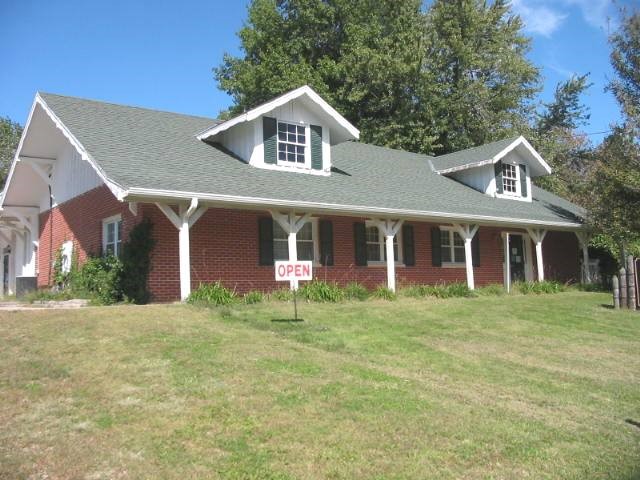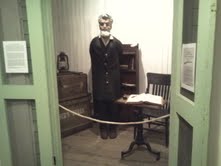 The Mayhew Cabin with John Brown’s Cave Museum is a tax-exempt 501(c)(3) non-profit museum in Nebraska City. It is dedicated to educating individuals about the Underground Railroad in Nebraska and its impact on the region. The site is also dedicated to the preservation of the original Mayhew Cabin and Nebraska City artifacts and their interpretation.
The Mayhew Cabin with John Brown’s Cave Museum is a tax-exempt 501(c)(3) non-profit museum in Nebraska City. It is dedicated to educating individuals about the Underground Railroad in Nebraska and its impact on the region. The site is also dedicated to the preservation of the original Mayhew Cabin and Nebraska City artifacts and their interpretation.
The museum interprets the history of the Mayhew Family’s involvement in the Underground Railroad. The family includes Allen and Barabara Mayhew, their many children, Barbara Mayhew’s brother, John Henri Kagi, who became an ally of the famous abolitionist, John Brown, in 1856. John Kagi would become one of John Brown’s most trusted advisors.
In early 1857 and at the direction of John Brown, John Kagi aided escaping slaves left Kansas Territory, accompanying them through Nebraska (and Nebraska City) and delivered them to other Underground Railroad conductors in Iowa. In December of 1858, John Brown and a group of his loyal followers, including John Henri Kagi, rode into Missouri under the cover of darkness from a very violent and “Bleeding Kansas” and at gunpoint took eleven slaves from their masters, including one heavily pregnant woman. The goal was to take the slaves to Canada and freedom. For weeks, these “fugitives” were hidden in various locations in northeast Kansas Territory. During that time, the pregnant woman gave birth to a son, who was named after John Brown. In early 1859, the then group of twelve were led out of Kansas Territory and taken north through Nebraska. In February of 1859, the twelve freedom seekers were given food and shelter at the modest home of John Kagi’s sister, Barbara Mayhew, at the now historic Mayhew Cabin in Nebraska City. The notorious reputation of John Brown and the murder of one of the slave owners in Missouri when the slaves were taken publicized the taking and the trek northward. Despite an armed posse attempting to take John Kagi at his sister’s cabin, the group of slaves made it safely across the river into Iowa and they eventually reached freedom in Windsor, Ontario, Canada in March of 1859. It was because of this event (and possibly other times when the Mayhew Cabin was used as part of the Underground Railroad) that the Mayhew property became known locally as “John Brown’s Cave.” The property was eventually turned into a nonprofit museum.
In January of 2010, the Mayhew Cabin Foundation, through a generous donation from the Wirth Foundation, purchased the museum building. The museum has previously occupied the rear portion of the building and it served as a gift shop, museum space, and office. After acquiring the building, the board members physically removed much of the interior drywall, framing/partitioning, and doors and then oversaw and/or physically took part in the renovation of the entire building. The renovated visitor’s center includes museum space, a media room with an orientation video, a temporary exhibit space, and a conference/meeting room. The building also has a kitchen, restrooms, and director’s office.
The conference/meeting room is available to rent for graduation parties, family get-togethers, or other special events. The room is 20 feet wide by 40′ long with adjacent kitchen (including a serving window) and handicap accessible restroom. The rental rate is $25 per hour with a $50 deposit due at the time of reservation. The deposit will go toward the rental fee. For an additional $50 fee, your guests can enjoy access to the museum and historic site. Contact us to reserve the room for your next event.

For several years, the temporary exhibit space has generally been used to exhibit artwork relating to John Brown. Within this space, you can meet a talking John Brown.
A new room was added to the museum space in 2015 dedicated solely to The Twelve. In late 2013, then Vice President, Cathleen Briley, realized that the museum focused solely on the rescuers (John Brown, John Kagi, and the Kagy/Mayhew families) and not on those that were aided. The names and identities of the twelve freedom seekers who were aided by the Mayhew’s in February of 1859 were unknown to us. To rectify that situation, she began the process of uncovering the identities of the former slaves. Because Underground Railroad activity was illegal and highly secretive, no records were kept, so uncovering information was difficult. Briley spent hundreds of hours researching utilizing various historical resources. During the process of identifying the names, she found herself becoming increasingly attached to the people and their families. They became affectionately known as “The Twelve.” After identifying ten of the twelve names, she began to track the families forward in time with the ultimate goal of locating a living descendant. That goal was accomplished early in 2014. Subsequent to the discovery, Briley wrote a book that details the history of a true American Hero, John Kagi, his involvement in Bleeding Kansas, the rescue of The Twelve, how the John Brown’s Cave site turned into the Mayhew Cabin with John Brown Cave Museum, the research into discovering the identities of The Twelve, and the successful search for living descendants.
There is ample more history about the Mayhew’s, John Kagi, and John Brown to discover at the museum. We hope to see you soon.
Update as of May 28, 2019: The brick museum building seen above was flooded and seriously damaged by rainwater over Memorial Day weekend. The building was considered to be unsafe for patrons. Over the same weekend, the tunnel and the cabin cellar were also flooded. The decision to close the overall museum site was clear. We are in the process of drawing up plans for a new museum building to be constructed on the site. Please make a donation to the Mayhew Cabin to help preserve this important historic site.
